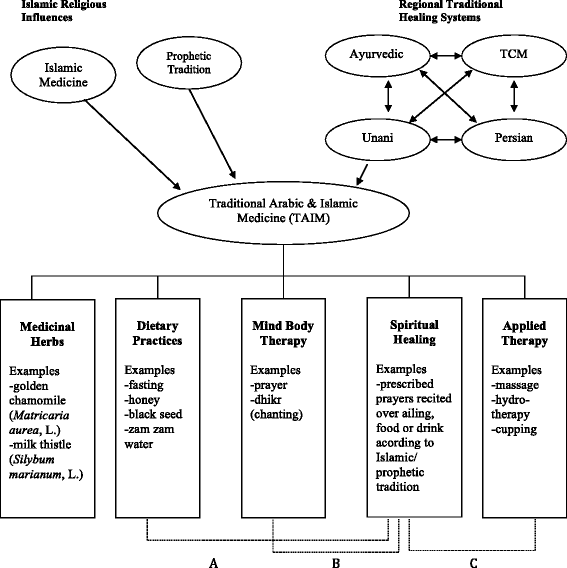Traditional Arabic & Islamic medicine: validation and empirical assessment of a conceptual model in Qatar
- PMID: 28292291
- PMCID: PMC5351166
- DOI: 10.1186/s12906-017-1639-x
Traditional Arabic & Islamic medicine: validation and empirical assessment of a conceptual model in Qatar
Abstract
Background: Evidence indicates traditional medicine is no longer only used for the healthcare of the poor, its prevalence is also increasing in countries where allopathic medicine is predominant in the healthcare system. While these healing practices have been utilized for thousands of years in the Arabian Gulf, only recently has a theoretical model been developed illustrating the linkages and components of such practices articulated as Traditional Arabic & Islamic Medicine (TAIM). Despite previous theoretical work presenting development of the TAIM model, empirical support has been lacking. The objective of this research is to provide empirical support for the TAIM model and illustrate real world applicability.
Methods: Using an ethnographic approach, we recruited 84 individuals (43 women and 41 men) who were speakers of one of four common languages in Qatar; Arabic, English, Hindi, and Urdu, Through in-depth interviews, we sought confirming and disconfirming evidence of the model components, namely, health practices, beliefs and philosophy to treat, diagnose, and prevent illnesses and/or maintain well-being, as well as patterns of communication about their TAIM practices with their allopathic providers.
Results: Based on our analysis, we find empirical support for all elements of the TAIM model. Participants in this research, visitors to major healthcare centers, mentioned using all elements of the TAIM model: herbal medicines, spiritual therapies, dietary practices, mind-body methods, and manual techniques, applied singularly or in combination. Participants had varying levels of comfort sharing information about TAIM practices with allopathic practitioners.
Conclusions: These findings confirm an empirical basis for the elements of the TAIM model. Three elements, namely, spiritual healing, herbal medicine, and dietary practices, were most commonly found. Future research should examine the prevalence of TAIM element use, how it differs among various populations, and its impact on health.
Keywords: Graeco Arabic medicine; Prophetic medicine; Quranic healing; Traditional medicine; Unani medicine.
Figures

References
-
- World Health Organization. General guidelines for methodologies on research and evaluation of traditional medicine. Geneva: World Health Organization. 2000. p. 1–71.
-
- Report of the IBC on Traditional Medicine Systems and their Ethical Implications [http://unesdoc.unesco.org/images/0021/002174/217457e.pdf].
-
- Folashade O, Omoregie H, Ochogu P. Standardization of herbal medicines-A review. International Journal of Biodiversity and Conservation. 2012;4(3):101–112.
-
- World Health Organization . Traditional Medicine. 2003.
MeSH terms
LinkOut - more resources
Full Text Sources
Other Literature Sources

